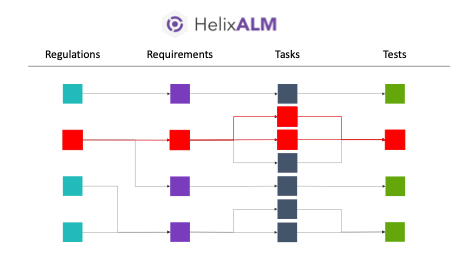Blog
September 29, 2020
Efficient Regulatory Testing for Requirements Changes
Data Management,
Security & Compliance,
Application Lifecycle Management
Those who work in regulated industries know that changes to regulations affect the way products are developed.
While such changes create extra work, there is a larger problem at hand. If the process of tracking regulations isn’t somehow linked to the system used to develop the product, it can be inefficient and unreliable to ensure the new regulations are met.
Let’s talk about what that means and how to correct it.
Compliance Testing, Conformance Testing, Regulatory Testing
While we refer to regulatory testing throughout this article, you may know it as compliance or conformance testing. What we discuss here is the testing that must occur when regulation changes impact one or more requirements. When a requirement changes, you may need to rerun or completely change your original test(s) for that requirement.
Back to top
The Challenge of Regulatory Changes
Teams struggle with regulatory changes when there is a disconnect between regulatory adherence and product development. This disconnect happens when regulations are tracked by different teams, and in different systems than those used to track requirements and testing on the product side.
There are two main reasons this may happen. Sometimes it’s because of an institutional gap —those on the product team simply aren’t regulatory experts, and vice versa. Other times it is a tool gap, where regulations can’t be tracked within the same tool as these other processes.
Consequently, when changes occur, the product teams have to manually check how each new regulation impacts their process.
What’s at Stake
Doing this process manually puts a lot on the line. If something is missed, you could face fines, or the potential for time-consuming rework. This applies to more than a single layer of the process. If testing has already started on a requirement that needs to be changed, all of that work has to be redone. That costs you labor, and can significantly delay your project milestones.
Ultimately, you need a way to link regulatory changes with your product development to produce faster and more confidently.
How to Make Regulatory Testing Efficient
Solving this problem begins with the right tool. Any good tool that handles requirements traceability should allow you to embed regulations into your requirements management. You should either be able to integrate, or better yet, import regulations directly into the tool. This allows you to trace directly from regulations to high-level requirements.
WEBINAR: How to import regulations directly into requirements management tool >>
High-level requirements mean your broadest, least granular requirements. For you, this might be product requirements, market requirements, business requirements, user needs, themes, or some other term you use to define high-level product goals.
By linking requirements and regulations, the resulting traceability should enable that tool to automatically notify you when a regulation gets updated. This notification provides a shortlist of product requirements that may be impacted by that regulatory change.
This list doesn’t just tell you what requirements need to be rewritten. Changes propagate to all of the teams using the requirements. So, you’ll know if you have to expand on testing, refactor testing, or rerun existing tests. You’ll know if you have to move testing from manual to automated or vice versa because of changing oversight needs.

Ultimately, when requirements are impacted by regulatory changes, the linking structure also lets you know which tests need to be evaluated. That automatic shortlist is the key to delivering faster releases and having more confidence in meeting compliance.
Back to top
Your Tool for Regulatory Compliance Testing
Perforce ALM (formerly Helix ALM) makes it easy to import regulations and link them to requirements. It provides end-to-end traceability — which means easier compliance and faster releases. And you can manage requirements, tests, and issues in a single platform. Try it free for 30 days.

